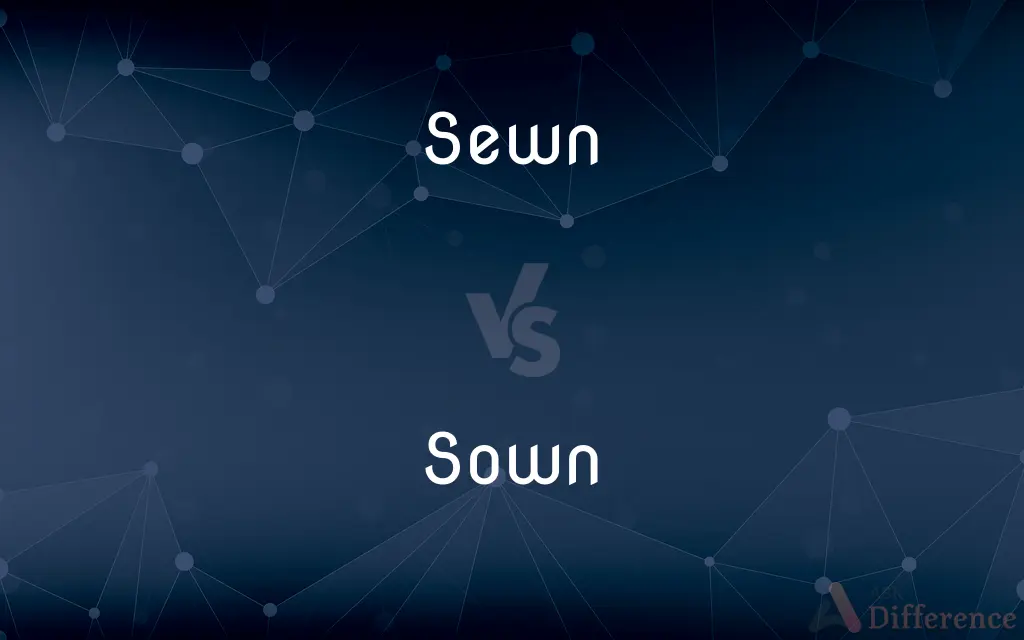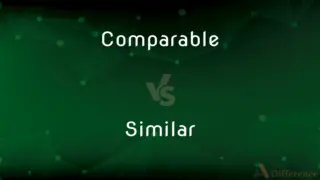Sewn vs. Sown — What's the Difference?
Edited by Tayyaba Rehman — By Urooj Arif — Updated on March 11, 2024
Sewn refers to joining or repairing materials, typically fabric, with a needle and thread, while sown relates to planting seeds in the ground for cultivation.

Difference Between Sewn and Sown
Table of Contents
ADVERTISEMENT
Key Differences
Sewn is the past participle of sew, which involves the action of using a needle and thread to join pieces of fabric or material together. This process is fundamental in the creation of clothing, upholstery, and various textile products. It requires skillful manipulation of thread and needle to produce durable and functional stitches. On the other hand, sown is the past participle of sow, meaning to plant or scatter seeds in or on the ground so that they may grow. This term is used in agriculture and gardening, highlighting the initial step in the cultivation of plants, vegetables, and crops. The success of sowing depends on factors like seed quality, soil conditions, and proper timing.
Sewing is an art and craft that has been practiced for thousands of years, evolving from hand stitching to the use of sophisticated sewing machines. It plays a crucial role in fashion and textile industries, enabling the production of bespoke garments and mass-produced clothing. Whereas sowing is a practice as old as agriculture itself, essential for food production, agriculture economy, and maintaining biodiversity. Techniques vary from broadcasting by hand to precise mechanical planters.
The skills required for sewing include dexterity, precision, and an understanding of fabrics and patterns. It can be a hobby, a professional craft, or an industrial operation. Sowing, however, often requires knowledge of agronomy, seasonality, and plant care, encompassing both small-scale gardening and large-scale agricultural operations.
Materials involved in sewing are diverse, ranging from natural and synthetic fabrics to threads of various thicknesses and colors. Sewing tools include needles, scissors, sewing machines, and sergers. In contrast, sowing involves seeds of different plant species and may require tools like hoes, trowels, and seed spreaders or planters.
The outcomes of sewing and sowing are distinctly different yet both rewarding. Sewing results in tangible products such as clothing, accessories, and home décor. Sowing's rewards are seen over time, culminating in the growth of plants, flowers, and crops that can provide food, beauty, and contribute to ecological health.
ADVERTISEMENT
Comparison Chart
Definition
Joining materials with needle and thread
Planting seeds in the ground
Primary Field
Textile, fashion
Agriculture, gardening
Skills Required
Dexterity, precision, understanding of fabrics
Knowledge of agronomy, seasonality
Materials/Tools
Fabrics, threads, needles, sewing machines
Seeds, hoes, trowels, planters
Outcome
Clothing, accessories, textile products
Growth of plants, vegetables, crops
Importance
Essential in fashion and textile industries
Crucial for food production, biodiversity
Techniques Variance
Hand stitching to machine sewing
Hand broadcasting to mechanical planting
Historical Aspect
Ancient craft, evolved with technology
As old as agriculture, essential for survival
Compare with Definitions
Sewn
Repairs tears in textiles.
The torn dress was expertly sewn back together.
Sown
Can involve scattering seeds.
Wildflowers were sown by scattering seeds over the soil.
Sewn
Involves joining fabric pieces.
The quilt was sewn with intricate patterns.
Sown
Requires understanding of planting seasons.
The garden was sown with vegetables at the optimal time for growth.
Sewn
Creates functional and decorative stitches.
The curtains were sewn with a hidden seam for a clean look.
Sown
The act of planting seeds.
The field was sown with wheat in early spring.
Sewn
Used in fashion and upholstery.
The sofa's cover was custom sewn to fit its dimensions perfectly.
Sown
Leads to crop cultivation.
The land was sown with corn, anticipating a rich harvest.
Sewn
Requires needles and thread.
The costume was sewn by hand, showcasing exceptional craftsmanship.
Sown
Aids in biodiversity.
A variety of herbs were sown to attract beneficial insects to the garden.
Sewn
A past participle of sew.
Sown
A past participle of sow1.
Sewn
Past participle of sew
Sown
Past participle of sow
Sewn
Fastened with stitches
Sown
Cultivated land inhabited by sedentary agriculturalists, in contrast to the nomad pastoralists of the steppe or desert.
Sown
Sprinkled with seed;
A seeded lawn
Common Curiosities
Which skill is older, sewing or sowing?
Both are ancient practices, but sowing, as a form of agriculture, might be as old as human civilization itself.
Can both sewn and sown activities be done by machines?
Yes, there are machines for both sewing textiles and sowing seeds.
How does the choice of material affect sewing?
The choice of fabric and thread affects the durability, appearance, and function of the sewn product.
Why is timing important in sowing?
Proper timing ensures that plants receive optimal conditions for germination, growth, and maturation.
Can sewn items be recycled?
Yes, sewn items can be repurposed or recycled, depending on the materials used.
Is sewing considered a sustainable practice?
Sewing can be sustainable, especially when it involves repairing or upcycling materials to reduce waste.
What is the main difference between sewn and sown?
Sewn relates to stitching materials together, while sown pertains to planting seeds.
How do climate conditions affect sowing?
Climate conditions, including temperature and rainfall, significantly influence seed germination and crop yield.
Can sowing affect local ecosystems?
Yes, the choice of plants and cultivation methods can influence local biodiversity and soil health.
What role does sowing play in food security?
Sowing is fundamental to agriculture and food production, directly impacting food availability and diversity.
How has the global textile industry impacted sewing practices?
The global textile industry has influenced sewing techniques, materials, and fashion trends, emphasizing both traditional craftsmanship and mass production.
What is the significance of heirloom seeds in sowing?
Heirloom seeds preserve genetic diversity and traditional plant varieties, often offering unique flavors and resilience.
What are the therapeutic benefits of sewing?
Sewing can offer mental health benefits, including stress relief and the satisfaction of creating something tangible.
Why is crop rotation important in sowing?
Crop rotation improves soil health, reduces pest buildup, and increases crop yield.
How does modern technology impact sewing and sowing?
Technology enhances efficiency and precision in both fields, from computerized sewing machines to GPS-guided seed planters.
Share Your Discovery

Previous Comparison
Branch vs. Twig
Next Comparison
Comparable vs. SimilarAuthor Spotlight
Written by
Urooj ArifUrooj is a skilled content writer at Ask Difference, known for her exceptional ability to simplify complex topics into engaging and informative content. With a passion for research and a flair for clear, concise writing, she consistently delivers articles that resonate with our diverse audience.
Edited by
Tayyaba RehmanTayyaba Rehman is a distinguished writer, currently serving as a primary contributor to askdifference.com. As a researcher in semantics and etymology, Tayyaba's passion for the complexity of languages and their distinctions has found a perfect home on the platform. Tayyaba delves into the intricacies of language, distinguishing between commonly confused words and phrases, thereby providing clarity for readers worldwide.
















































